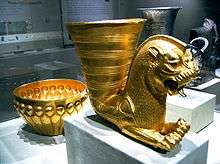Achaemenid Persian Lion Rhyton
The Achaemenid Persian Lion Rhyton (in Persian:"تکوک شیر غران") is an ancient artifact related to Achaemenians.

A rhyton is a kind of vessel which normally has the shape of an animal's head or horns. These vessels were common in middle east Asia and ancient Greece.[1]
Early Iranians had rhytons with an animal head at the end of the vessel; Later in Achaemenid period the animal part of the rhyton was usually located in front of it and has a 90 degree angle to the vessel.
The rhyton has been created in 500 B.C by estimates. It has 6.7 in. height (about 17 cm.) and is totally made up of gold. The different parts of the artifact are joined together by soldering skilfully that observers can't even see any trace. It was believed by people that if someone drinks a little bit of the vessel's content, he/she could acquire superhuman powers.
This lion head creature was found by Fletcher Fund in 1954 in southwest Persia and is now located in Metropolitan Museum of Art in New York, United States.[2]
References
- ↑ "The Persians: Archaeology of Achaemenid Persia". Wfltd.com. Retrieved 2015-07-28.
- ↑ "Vessel terminating in the forepart of a lion [Iran]" (54.3.3) In Heilbrunn Timeline of Art History . New York: The Metropolitan Museum of Art, 2000–. http://www.metmuseum.org/toah/works-of-art/54.3.3. (October 2006)